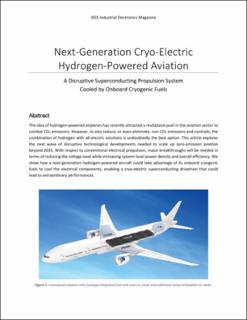| dc.contributor.author | Nøland, Jonas Kristiansen | |
| dc.contributor.author | Mellerud, Runar | |
| dc.contributor.author | Hartmann, Christian Magnus | |
| dc.date.accessioned | 2022-08-08T07:57:13Z | |
| dc.date.available | 2022-08-08T07:57:13Z | |
| dc.date.created | 2022-06-03T01:53:28Z | |
| dc.date.issued | 2022 | |
| dc.identifier.issn | 1932-4529 | |
| dc.identifier.uri | https://hdl.handle.net/11250/3010523 | |
| dc.description.abstract | The idea of hydrogen (H2)- powered airplanes has recently attracted a revitalized push in the aviation sector to combat carbon dioxide (CO2) emissions. However, to also reduce, or even eliminate, non-CO2 emissions and con- trails, the combination of H2 with all-electric solutions is undoubtedly the best option. This article explores the next wave of disruptive technological developments needed to scale up zero-emission aviation beyond 2035. With respect to conventional electrical propulsion, major breakthroughs will be needed in terms of reducing the voltage level while increasing system-level power density and overall efficiency. We show how a next-generation H2-powered aircraft could take advantage of onboard cryogenic fuels to cool the electrical components, enabling a cryo-electric super- conducting drivetrain that could lead to extraordinary performance. | en_US |
| dc.description.abstract | Next-Generation Cryo-Electric Hydrogen-Powered Aviation: A Disruptive Superconducting Propulsion System Cooled by Onboard Cryogenic Fuels | en_US |
| dc.language.iso | eng | en_US |
| dc.publisher | IEEE | en_US |
| dc.relation.uri | https://ieeexplore.ieee.org/stamp/stamp.jsp?tp=&arnumber=9786856 | |
| dc.title | Next-Generation Cryo-Electric Hydrogen-Powered Aviation: A Disruptive Superconducting Propulsion System Cooled by Onboard Cryogenic Fuels | en_US |
| dc.title.alternative | Next-Generation Cryo-Electric Hydrogen-Powered Aviation: A Disruptive Superconducting Propulsion System Cooled by Onboard Cryogenic Fuels | en_US |
| dc.type | Journal article | en_US |
| dc.type | Peer reviewed | en_US |
| dc.description.version | acceptedVersion | en_US |
| dc.rights.holder | © 2022 IEEE. Personal use of this material is permitted. Permission from IEEE must be obtained for all other uses, in any current or future media, including reprinting/republishing this material for advertising or promotional purposes, creating new collective works, for resale or redistribution to servers or lists, or reuse of any copyrighted component of this work in other works. | en_US |
| dc.source.journal | IEEE Industrial Electronics Magazine | en_US |
| dc.identifier.doi | 10.1109/MIE.2022.3174332 | |
| dc.identifier.cristin | 2029265 | |
| cristin.ispublished | true | |
| cristin.fulltext | postprint | |
| cristin.qualitycode | 1 | |
